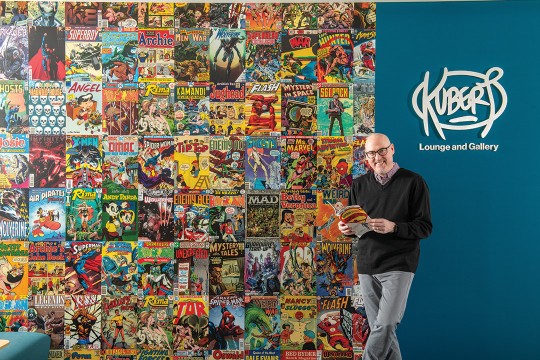Color Science Master of Science Degree

Color Science
Master of Science Degree
- RIT /
- Rochester Institute of Technology /
- Academics /
- Color Science MS
A unique master’s degree that decodes how humans perceive and interact with color, providing limitless real-world applications.
30%
Merit scholarship
Overview for Color Science MS
Why Study Color Science at RIT?
STEM-OPT Visa Eligible: The STEM Optional Practical Training (OPT) program allows full-time, on-campus international students on an F-1 student visa to stay and work in the U.S. for up to three years after graduation.
Unique Program: Explore the rich and dynamic field of color science at the only university in the nation offering this specialized program, encompassing both theoretical foundations and hands-on applications.
Interdisciplinary Approach: Tailored for students from diverse backgrounds including physics, biology, engineering, and more, the program offers a comprehensive understanding of color science, allowing for specialization aligned with individual interests and expertise.
Cutting-Edge Research Opportunities: Engage in innovative projects such as exploring color perception in augmented reality, applications of color in agriculture, and advancements in color imaging technologies, conducted within the world-renowned Munsell Color Science Laboratory.
In-Demand Career Pathways: Graduates of the program are in high demand across various industries including electronic imaging, color instrumentation, research, and development. Alumni have secured positions at prestigious companies such as Apple, Google, Microsoft, and Samsung, showcasing the program’s relevance and impact in today’s technological landscape.
At the only university in the nation offering this program of study, you will be exposed to the rich, dynamic field of color science through theory and practical application.
The study of color is a fundamental field of science that is dedicated to understanding the creation of colored stimuli, sources of illumination, and ultimately the human perception of color.
RIT’s color science degree provides a graduate-level study in both scientific theory and practical application. The program provides you with a broad exposure to the field of color science and affords them the unique opportunity of specializing in an area appropriate for their background and interest. This objective is accomplished through the program’s core courses, selection of electives, and completion of a thesis or graduate project.
RIT’s Color Science Degree
The color science degree is designed for students from a wide range of undergraduate degrees. If you completed a program in physics, biology, chemistry, mathematics, computer science, engineering, neuroscience, experimental psychology, imaging, or any applied discipline pertaining to the quantitative description of color, this program could be a good fit for you
Color science is used everyday: in the design and control of most man-made colored materials including textiles, coatings, and polymers; to specify such diverse materials as soil and wine; and, in digital photography, desktop and projection display, and printing.
Where other programs may address just optics or just materials, just lighting or just perception; here you’ll learn the full range of color science. This includes the fundamental concepts of color science and its applications, as well as how to do research in the field and present it successfully.
RIT Color Science students work on projects including:
- Color Perception in Assisted Reality/Virtual Reality
- Color in Agriculture
- Color Imaging (Cameras and Displays, e.g. smartphones)
- Individual Differences in Human Color Perception
- Limits of Human Color Vision
Study color at the world-renowned Munsell Color Science Laboratory, only offered here at RIT.
The Study of Color
The color science degree is a combination of required courses in color science, elective courses appropriate for the candidate’s background, and either a research thesis or graduate project.
For full-time students, the program requires three to four semesters of study. Part-time students generally require two to four years of study.
The color science program is designed for students with an undergraduate degree in a scientific or another technical discipline. Those with adequate undergraduate work in related sciences start the program as matriculated graduate students.
Students without adequate undergraduate work in related sciences must take foundation courses prior to matriculation into the graduate program. A written agreement between the candidate and the program coordinator will identify the required foundation courses.
Color Science Careers
Alumni of our programs are in high demand and uniquely qualified to address the full breadth of color science in multidisciplinary teams. Color science degree graduates have accepted positions in electronic imaging, color instrumentation, colorant formulation, and basic and applied research. A sample of companies that have hired our graduates include Apple, Dolby Laboratories, Google, Benjamin Moore, Canon Corp., Hallmark, Hewlett Packard Corp., Microsoft Corp., Pantone, Qualcomm Inc., Ricoh Innovations Inc., LG Electronics, and Samsung.
-
30% Tuition Scholarship for NY Residents and Graduates
Now is the perfect time to earn your Master’s degree. If you’re a New York state resident with a bachelor’s degree or have/will graduate from a college or university in New York state, you are eligible to receive a 30% tuition scholarship.
Careers and Experiential Learning
Typical Job Titles
| Imaging Engineer | Color/Imaging Scientist |
Cooperative Education
What makes an RIT science and math education exceptional? It’s the ability to complete science and math co-ops and gain real-world experience that sets you apart. Co-ops in the College of Science include cooperative education and internship experiences in industry and health care settings, as well as research in an academic, industry, or national lab. These are not only possible at RIT, but are passionately encouraged.
At the graduate level, and paired with an advanced degree, cooperative education and internships give you the unparalleled credentials that truly set you apart. Learn more about graduate co-op and how it provides you with the career experience employers look for in their next top hires.
National Labs Career Events and Recruiting
The Office of Career Services and Cooperative Education offers National Labs and federally-funded Research Centers from all research areas and sponsoring agencies a variety of options to connect with and recruit students. Students connect with employer partners to gather information on their laboratories and explore co-op, internship, research, and full-time opportunities. These national labs focus on scientific discovery, clean energy development, national security, technology advancements, and more. Recruiting events include our university-wide Fall Career Fair, on-campus and virtual interviews, information sessions, 1:1 networking with lab representatives, and a National Labs Resume Book available to all labs.
Featured Work and Profiles
-
A Colorful Journey: From Air Force to an MS in Color Science
Justin Laird BS ’03, MS ’05, an Air Force Veteran, discovered the unique field of color science and is now a Senior Quality Engineer for Color at Apple.
Read More about A Colorful Journey: From Air Force to an MS in Color Science -
Will Wine Taste Different If You Drink It Outside?
Mark Fairchild, director of the RIT Color Science/Munsell Color Science Laboratory discusses his research, The Colors of Wine. It’s more complex than you think.
Read More about Will Wine Taste Different If You Drink It Outside?
Curriculum for 2024-2025 for Color Science MS
Current Students: See Curriculum Requirements
Color Science, MS degree, typical course sequence
| Course | Sem. Cr. Hrs. | |
|---|---|---|
| First Year | ||
| CLRS-601 | Principles of Color Science This course covers the principles of color science including theory, application, and hands-on experience incorporated into the lectures. Topics include color appearance (hue, lightness, brightness, chroma, saturation, colorfulness), colorimetry (spectral, XYZ, xyY, L*a*b*, L*C*abhab, ΔE*ab, ΔE00), the use of linear algebra in color science and color imaging, metamerism, chromatic adaptation, color inconstancy, color rendering, color appearance models (CIECAM02), and image appearance models (S-CIELAB, iCAM). (Prerequisites: Graduate standing in CLRS-MS, IMGS-MS, CLRS-PHD or IMGS-PHD.) Lecture 3 (Fall). |
3 |
| CLRS-602 | Color Physics and Applications This course explores the relationship between a material’s color and its constituent raw materials such as colorants, binding media, substrates, and overcoats. These can be determined using a variety of physical models based on absorption, scattering, luminescence, and interference phenomena. These models enable the production of paints, plastics, colored paper, printing, and others to have specific colors. Accompanying laboratories will implement and optimize these models using filters, artist opaque and translucent paints and varnishes including metallic and pearlescent colorants, and inkjet printing. Statistical techniques include principal component analysis and linear and nonlinear optimization. (Prerequisites: CLRS-601 or equivalent course.) Lecture 3 (Spring). |
3 |
| CLRS-720 | Computational Vision Science Computational Vision Science This course provides an introduction to modern computer-based methods for the measurement and modeling of human vision. Lectures will introduce the experimental techniques of visual psychophysics including threshold measurement, psychometric functions, signal detection theory, and indirect, direct, and multidimensional scaling. Lectures will also introduce the MATLAB technical computing environment and will teach how to use MATLAB to run computer-based psychophysical experiments and to analyze experimental data and visualize results. Laboratory exercises will provide practical experience in using computer-based tools to conduct psychophysical experiments and to develop computational models of the results. Prior experience in vision science and/or scientific computing will be helpful but is not required. (Prerequisites: Graduate standing in CLRS-MS, IMGS-MS, CLRS-PHD or IMGS-PHD.) Lecture 3 (Fall). |
3 |
| CLRS-750 | Historical Research Perspectives Historical Research Perspectives is a weekly forum in which students will learn about historical and classic topics in color science. The course focuses on journal club discussions of papers selected by the students and faculty. It also includes oral presentations from students, laboratory staff, and faculty as well as visiting speakers from within and external to RIT. Students will prepare their own oral presentations and written assignments based on the course readings and independent research. Students will develop professional skills required for formal scientific presentations and writing. (Prerequisites: Graduate standing in CLRS-MS or CLRS-PHD.) Seminar 1 (Fall). |
1 |
| CLRS-751 | Research and Publication Methods Color Science Seminar II is a weekly forum in which students will learn about current research topics in color science. The course focuses on journal club discussions of papers selected by the students and faculty. It also includes oral presentations from students, laboratory staff, and faculty as well as visiting speakers from within and external to RIT. Students will prepare their own oral presentations and written assignments based on the course readings and independent research. Students will further develop professional skills required for formal scientific presentations and writing. A draft thesis or dissertation proposal will also be prepared. (Prerequisites: CLRS-750 or equivalent course.) Seminar 2 (Spring). |
2 |
| CLRS-820 | Modeling Visual Perception This course presents the transition from the measurement of color matches and differences to the description and measurement of color appearance in complex visual stimuli. This seminar course is based mainly on review and student-led discussion of primary references. Topics include: appearance terminology, appearance phenomena, viewing conditions, chromatic adaptation, color appearance modeling, image appearance, image quality, and material appearance. (Prerequisites: CRLS-601 and CLRS-720 or equivalent courses.) Lecture 3 (Spring). |
3 |
Graduate Electives |
6 | |
| Second Year | ||
| CLRS-890 | Research & Thesis Masters-level research by the candidate on an appropriate topic as arranged between the candidate and the research advisor. (Enrollment in this course requires permission from the department offering the course.) Thesis (Fall, Spring, Summer). |
6 |
Elective |
3 | |
| Total Semester Credit Hours | 30 |
|
Students are also interested in
Admissions and Financial Aid
This program is available on-campus only.
| Offered | Admit Term(s) | Application Deadline | STEM Designated |
|---|---|---|---|
| Full‑time | Fall | January 15 priority deadline, rolling thereafter | Yes |
| Part‑time | Fall | Rolling | No |
Full-time study is 9+ semester credit hours. Part-time study is 1‑8 semester credit hours. International students requiring a visa to study at the RIT Rochester campus must study full‑time.
Application Details
To be considered for admission to the Color Science MS program, candidates must fulfill the following requirements:
- Complete an online graduate application.
- Submit copies of official transcript(s) (in English) of all previously completed undergraduate and graduate course work, including any transfer credit earned.
- Hold a baccalaureate degree (or US equivalent) from an accredited university or college. A minimum cumulative GPA of 3.0 (or equivalent) is recommended.
- Submit a current resume or curriculum vitae.
- Submit a personal statement of educational objectives.
- Submit two letters of recommendation.
- Entrance exam requirements: None
- Submit English language test scores (TOEFL, IELTS, PTE Academic), if required. Details are below.
English Language Test Scores
International applicants whose native language is not English must submit one of the following official English language test scores. Some international applicants may be considered for an English test requirement waiver.
| TOEFL | IELTS | PTE Academic |
|---|---|---|
| 100 | 7.0 | 70 |
International students below the minimum requirement may be considered for conditional admission. Each program requires balanced sub-scores when determining an applicant’s need for additional English language courses.
How to Apply Start or Manage Your Application
Cost and Financial Aid
An RIT graduate degree is an investment with lifelong returns. Graduate tuition varies by degree, the number of credits taken per semester, and delivery method. View the general cost of attendance or estimate the cost of your graduate degree.
A combination of sources can help fund your graduate degree. Learn how to fund your degree
Research
Research conducted in the color science master's degree program revolves around the activities of the Munsell Color Science Laboratory, which is the pre-eminent academic laboratory in the country devoted to color science. Research is currently exploring:
- color appearance modeling
- lighting
- image quality
- spectral-based image capture
- archiving
- reproduction of artwork
- color management
- computer graphics
- AR/VR
- material appearance
The Munsell Laboratory has many industrial relationships that can provide you with summer and full-time job opportunities across the United States and abroad.
Related News
-
October 9, 2024
![an orange and yellow leaf appears next to a thin vertical bar with reds, oranges, yellows, and greens on it. To the right of the leaf, the title of the book, Munsell Trees appears.]()
The color science of leaves in a western New York park is focus of RIT Press book
Black oak, crabapple, crimson maple—a color scientist finds inspiration in the woods in the new book Munsell Trees: A Season of Leaves and Colors, published by RIT Press.
-
May 7, 2024
![a man stands next to a wall covered in comic book covers. On the right side of the wall there is a sign that says Kubert Lounge and Gallery.]()
Comics go to College
The comics collection at RIT is growing by leaps and bounds and the new Kubert Lounge and Gallery makes it a visible presence on campus. The interdisciplinary art form is right at home at RIT.
-
May 1, 2024
![a student sits in front of and behind monitors.]()
Students score with RIT Sports Network
Since 2002, more than 1,200 students have gained valuable experience creating a multimedia production ensemble with RIT Sports Network.
Contact
- Lindsay Lewis
- Senior Assistant Director
- Office of Graduate and Part-Time Enrollment Services
- Enrollment Management
- 585‑475‑5532
- lslges@rit.edu
Integrated Sciences Academy



















